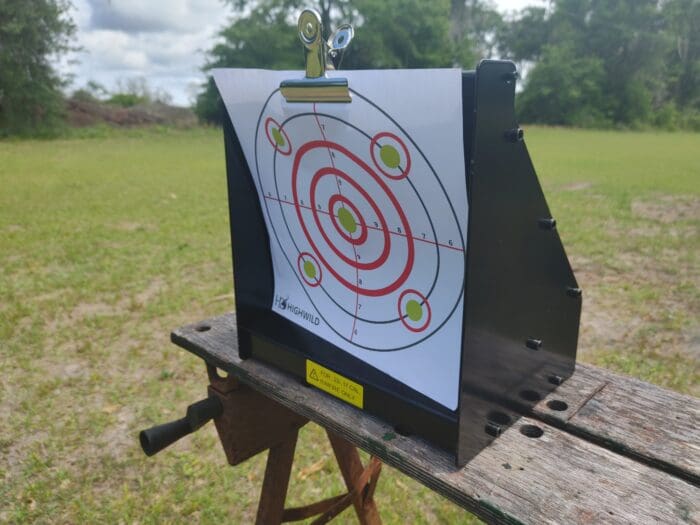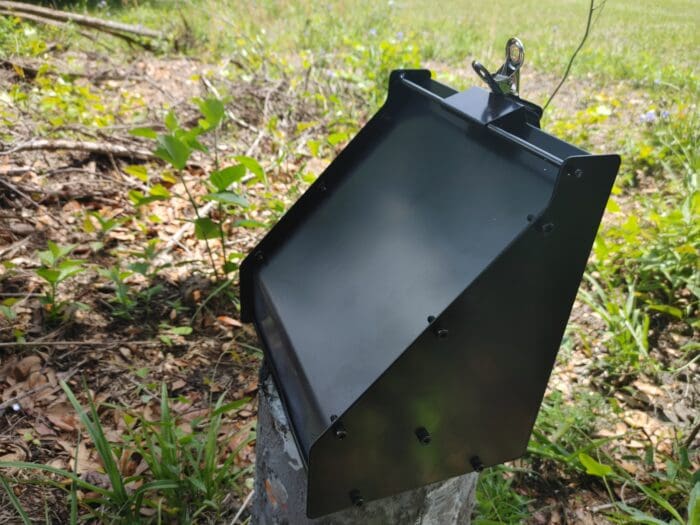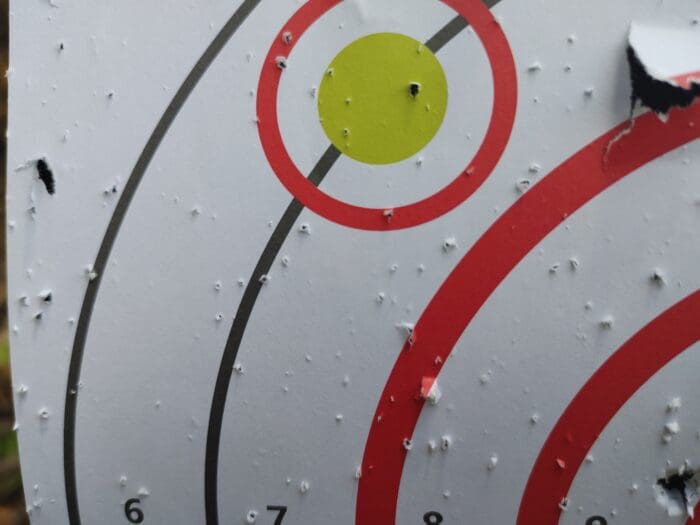I’m moving, and I hate it. Moving truly sucks, and what sucks the most is moving away from the home range I’ve built.
I have plans for a new range, but that’s a little ways down the road as of now. To keep my trigger finger from itching too much, I bought a bullet trap. I actually had no idea these existed for actual firearms at an affordable price point. I only randomly stumbled across the Highwild Bullet Trap and for a little less than $50, I hit buy-it-now.

Who is Highwild? It seems like they are a small company that makes steel targets and similar goodies. They are based out of Canada, according to their website, but they don’t have a large footprint.
I know of them because I received a Highwild target set a few years ago, and it’s been a fantastic addition to my home range. I figured for $50 I could eat the cost if the bullet trap was shoddily made and unsafe.
A few days later, I had a hefty cardboard box waiting on my porch. This particular model is for rimfire only, and I tend to shoot .22LR more than anything else, so it would work just fine until I put my new range together.
Putting the Bullet Trap Together
Assembly was fairly easy. The bullet trap comes in four main parts, a bottom, two sides, and a back portion. Alongside it are a small metal bar, a bracket, a target clip, and several bolts.
An Allen key is the only tool needed to assemble the thing. The instructions are fairly vague. I just attached the sides to the bottom and then added the heavy-duty back portion. With the Allen key in hand, I tightened it all down, and in about ten minutes, I had my bullet trap.

There are a few holes in the bottom, and Highwild sells a separate mount that allows the bullet trap to be attached to a 2×4. Not a bad idea, but not something I’ll use right now. Once the trap is built, your shooting area is roughly 11 inches by 11 inches. It’s fairly large for some basic practice and to scratch my itch for recreational shooting.
The bullet trap comes with two paper targets but could accept most targets, especially if you are willing to print your own.
To The Range
Testing a bullet trap seems fairly simple, but for safety’s sake, I did it with a berm behind the trap, which is always a good idea. I had no experience with it. Maybe it’s so cheaply made that .22LR will just zip through it. It’s even possible — though highly unlikely — that I’d miss. I didn’t want to take that chance at my new place.
With that in mind, I dropped it in front of the berm. I grabbed my Ruger 10/22 and Ruger LCP 2 in .22LR. This bullet trap advises rimfire .22 and .17 only.

Highwild states the minimum distance for .22 is 30 yards, and the minimum for .17 HMR is 75 yards. I don’t shoot much .17, so that wasn’t a worry.
With the Rugers in hand, I lined up and started launching rounds downrange. Every ten rounds, I’d check the bullet trap. I also fired rounds near the top and bottom of the target to see what happens when you shoot a little higher or lower than the center. I wanted to test for ricochets or damage to the bullet trap.

Regardless of where the bullet hit, the trap absorbed them all. There was no damage, and nothing zipped through the target. The bullet trap is angled to absorb the shots and divert them downward. It does that with ease, and there isn’t even a dent after fifty rounds fired at somewhat close range.
Getting Close
That minimum range is in place to prevent the blowback from the projectiles hitting the bullet trap and creating splashback. If you get fairly close to the bullet trap, you could get hit with splashback. Eye pro becomes even more mandatory than usual within 15 yards or so. There is no recommendation for projectile or FPS ratings, but I used standard bulk ammo from Federal and Aguila with no problems.

The Highwild will likely be getting lots and lots of use in the next few months as I get my new home range built. I will build a small berm behind the target just in case, and it likely won’t be used for dynamic shooting of any kind. I’ll probably shoot Dot Torture and work on my fundamentals.
For the price point, the Highwild Bullet Trap is a fair bargain. It’s certainly handy for my uses, and it seems like a great place to start building your own home range. Maybe parlor ranges and parlor pistols can make a comeback.





That was interesting. What were shipping costs from Canada?
Flag, like you, I’m also in Florida, and according to the ‘calculate shipping’ section on Amazon, the all-up-shipped-to-your-door price was…
$63.69
Not bad…
looks ideal. a tilted plate and a bulldog clip.
i remember a similar marxman pellet trap for my first crosman mkll. actually had little ducks on parade that knocked over, couple other critters.
i think,growing up,we had the same.it was a big suprise 1 Christmas as my Father announced we were going to learn how to shoot
“will build a small berm behind the target just in case…”
if you are going to build a berm anyway then why bother with the bullet trap and why not just do a berm for a ‘range’ use and use that and improve later?
The first gun store I worked for 30+ years back had one of those on the top shelf of the far display case. The trap itself was semi-coiled steel, a little like the one discussed here.
The bullet impacted on an angle, and the next surface it struck deflected it again and again as the coil tightened. After 50 rounds or so, it started getting smokey inside.
We’d leave in a cloud of .22lr smoke, but by the next morning you couldn’t smell a thing in there. Also shot pellet guns at it, as well.
If someone had a basement and a silencer, they could likely get away with an incognito indoors gun range, if they wanted to…
I still have my Crosman pellet trap from when I was little. It has 5 ‘knock-down’ targets inside it. Shoot the 2 outside ones and they get held down by magnets. Then shoot the middle target to ‘reset’ them. I may need to break it out again and start shooting inside my home more often…
I’d be interested to hear the long term report after a couple-few thousand rounds.
11×11 is to small for me. I need somthing about the size of a barn.
“I need somthing about the size of a barn.”
The same here, ‘Marsupial One’… 🙁
And this makes three.
I am wondering if you could dump a bag of sand into the bottom of that trap to absorb the bullets after they deflect off of the back piece? It seems like that would virtually eliminate bullet splatter leaving the trap.
On the one we had in the shop, the lead tended to splatter when the bullets hit the first surface of trap.
Try it for yourself and what happens…
Parlor pistols coming back… that’s dream to come true. simpler times when men were men.
I do believe CCI still makes .22 CB caps, a little spit of lead, and just the energy of the primer for propellant :
https://www.cci-ammunition.com/rimfire/cci/cb/6-26.html
we pop calibris in the city from an naa. nobody cares, they are quiet. rats don’t like ’em.
I thought the same thing when I got my first suppressor. Shoot in the garage and nobody will notice. Wrong! Sounds like a ball-peen hammer hitting a gong when the bullet hits the back. Impact noise can’t be effectively moderated. Even tried different backings to lessen the sound. Killed my thoughts of an indoor range in the suburbs.
I’d really like to see you do a torture test of this. How far can you get from 22LR before the trap starts to fail?
Had one of these (or one made in a similar way) for decades. I really don’t recall the manufacturer of the one I have. Very useful for .22 and for my air rifles. Be careful of the lead dust as you empty the caught bullets in the bullet trap trough. Wear disposable gloves and a dust mask.
The High wind Bullet Trap is very handy in backyard shooting practice.
Comments are closed.